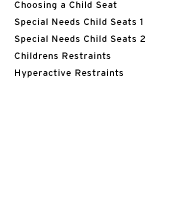To
assist you in selecting the correct child seat, our range is
divided into several categories or groups by the weight range
for which they are suitable. These groups correspond broadly
to approximate age groups, but remember that it is the weight
of the child which is the critical factor in choosing a suitable
child car seat. We do not recommend that you use a forward-facing
seat until a child is above the minimum weight (9kg) and able
to sit unaided.
|
Group
0 Up
to 10kg (22lbs)
A rearward-facing seat which can be used in the front or
rear of the car. Never use a rearward facing infant carrier
or child seat on a passenger seat fitted with an airbag. |
|
Group
0+ Up
to 13kg (29lbs)
A rearward-facing seat which can be used in the front or
rear of the car. Never use a rearward facing infant carrier
or child seat on a passenger seat fitted with an airbag. |
|
Group
1 9kg
- 18kg (20 - 40lbs)
A forward-facing seat which can be used in the front or
rear of the car. Generally these have a choice of upright
and reclined positions. |
|
Group
2 15kg
- 25kg (33 - 55lbs)
A forward-facing seat or booster which can be used in the
front or rear of the car. The booster seat lifts the child
and positions adult lap and diagonal seat-belt correctly.
N.B. A booster seat lifts the child, allowing the use of
adult lap and diagonal seat-belts. Some may have shoulder-belt
guides for added comfort. |
|
Group
3 22kg
- 36kg (44 - 79lbs)
A forward-facing seat or booster which can be used in the
front or rear of the car. |
The
groups listed correspond to the weight ranges in European Standard
applying to child car seats. When groups overlap - Some overlap
between Groups/weight-ranges does occur. As car seats are designed
with versatility in mind, you will notice that certain of our
child seats are approved in two groups or more.
Just remember the child’s weight is the determining factor
in selecting the right seat.




